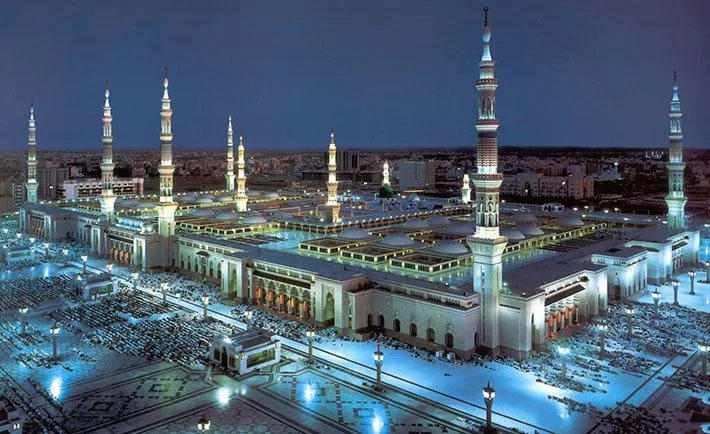Are you planning to visit Masjid Nabawi in which Medina Al-Munawarah is the capital city?
Medina has demonstrated throughout history that it is the city of light and hope for Muslims all around the world.
Muslims all over the globe who have visited Medina claims as Medina is so peaceful, the reason behind is simple, it’s a city of Prophet Muhammad ﷺ and there is a mosque of Prophet Muhammad ﷺ as well.
From the Prophet’s Mosque to the Rawdah, experience the holiness and historical significance of each site which are mentioned below.
Unlike Mecca, non-Muslims or tourists are allowed to visit Medina – It’s open for everyone.
Top Places of Medina to visit
Muslim pilgrims travel to Medina to perform 40 rakats of salah at the Prophet Muhammad’s ﷺ mosque after completing the pilgrimage in Mecca.
Masjid Al-Nabawi is open 24 hours and seven days a week, 24/7.
Haram is an Arabic word which means, sanctuary, means a holy or sacred place so Prophet Mosque’s ﷺ is called “Haram”.
Many Muslims wishes to do Niqah in Masjid Nabwi or the Masjid Haram in Mecca. It’s been done by plenty of people already.
Bilal ibn Rabah, a freed slave with Abyssinian ancestry, served as the first muezzin in Islam and gave first adhan in Medina.
Al-Masjid an-Nabawi / Prophet’s صلى الله عليه وسلم Mosque
The second holiest place for the Muslims community to visit for the inner peace through the worship, this mosque is located in the Medina, Kingdom of Saudi Arabia.
The most special and most beautiful Mosque in the world with its architecture is “Masjid-al-Nabwi“.
Over the centuries, it has undergone several expansions, making it one of the world’s largest mosques today.
Masjid al-Nabawi is one of the most popular Ziyarah sites due to the graves of the Prophet ﷺ and two of his most faithful companions, Abu Bakr al-Siddiq رضي الله عنهماand Umar ibn al-Khattab رضي الله عنهما.
This mosque was built in the first year of Hijrah (622 CE), after the arrival of Prophet Muhammad ﷺ, this mosque is built with the capacity of 1,000,000 people at a time.
Important places inside Masjid an-Nabawi
House of Fatima

Fatima has been compared to Mary, the mother of Jesus, especially in Shia Islam.
During the time when it was included in the Prophet’s ﷺ Mosque, Syeda Fatima built the house and well inside it herself in Masjid Nabawi.
Hazrat al-Hussain ibn Ali’s young daughter Fatima died in 110 AH when her father went to battle in Karbala.
The Rawdah ( الروضة); “The Garden”; also “Rawda” or “Rauda”), sometimes called al-Rawdah al-Shareef (الروضة الشريفة; “The Exalted Garden”) is one of the Riyadhul Jannah ( رياض الجنه; “Gardens of Paradise”) and refers to the area between the Prophet’s tomb and his minbar.
It is a place of immense spiritual and historical significance.
It contains six pillars which stand on the exact places where the original columns, made from date palm trunks, stood during the Prophet’s life.
In one hadith, the grave of the Prophet ﷺ that is mentioned, rather than his house:
Between my grave and my pulpit is one of the gardens of paradise.
Narrated by Ahmad, Bayhaqi and Ibn Abi Shayba
Roza e Rasool
As a result of completing the Hajj or Umrah, a visit to Madinah and the grave of the master of Prophets ﷺ is a Sunnah, some scholars have considered it close to the Wajib.
Muslims have consistently, from the early righteous Muslim generations, visited him and expended much effort to travel to him.
This is because it is among the most meaningful and beneficial acts accepted by Allah.
It is an excellent way of attaining spiritual elevation and increasing your love for the Prophet ﷺ.
Abdullah ibn Umar I reported that the Messenger of Allah ﷺ said:
The person who performs Hajj then visits my grave after my death, is like he who visited me during my lifetime.
Dar Qutni, At-Tabrani and Al-Bayhaqi.
Grave and Tomb of the Prophet ﷺ
The Prophet ﷺ is buried in the Sacred Chamber, along with two of his most faithful companions and the first two caliphs of Islam, Abu Bakr al-Siddiq and Umar ibn al-Khattab.
Once the house of his wife Aisha, the Sacred Chamber is today a part of Masjid Nabawi’s complex and house to some of the world’s most venerated tombs.
The graves are surrounded by several walls without windows or doors and thus can’t be seen or accessed.
It has four doors
- Bab al-Tahajjud ( باب التهجد; The Door of Tahajjud)
- Bab al-Tawba ( باب التوبة; The Door of Repentance)
- Bab Aisha ( باب عائشة; The Door of Aisha) or Bab al-Wufud ( باب الوفود; The Door of Delegations)
- Bab Fatima (باب فاطمة; The Door of Fatima)
Other Places to visit inside in Masjid e Nabwi are
- Praying spot of Prophet Muhammad
- Mehrab-e-Tahajjud
- Riyadhul Jannah.
- Mehrab-e-Nabawi.
- Ashab us-Suffah platform
- Mimbar (pulpit)
There are no any Entry fee or visit charges, it is free to go for everyone.
Mosques in Medina
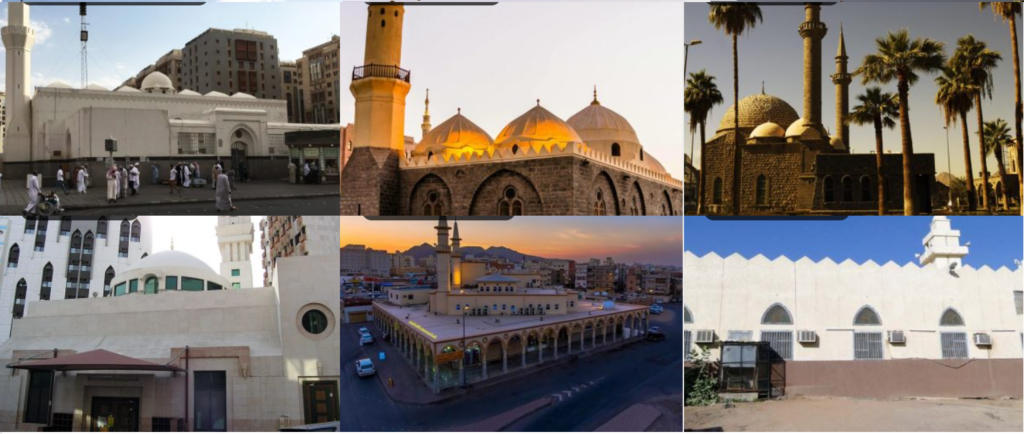
Masjid al-Qiblatayn
Masjid al-Qiblatayn is one of the most historical Mosques in Medina, in which Prophet Muhammad ﷺ ordered to change the direct of Qibla from Jerusalem to Makkah.
It has two prayers or Qiblas ideal positions (Sawad bin Ghanam bin Kaab was the founder) during the second Hijra’s year which is called mihrabs, for that it is called Masjid al-Qiblatayn which is unique among all.
It acquires the capacity of 2,000 worshippers.
The Seven Mosques / Saba Masjid
The Saba Masjid (Saba Masajid), often referred to as the Seven Mosques, is a collection of modest, ancient mosques situated on the western side of the Sala’ Mountain in the Blessed City of Medina.
The word “Saba” is Arabic word which means “seven,” and the this mosque is initially consisted of seven mosques, six mosques are a part of the complex as of right now, though.
The seven mosques are;
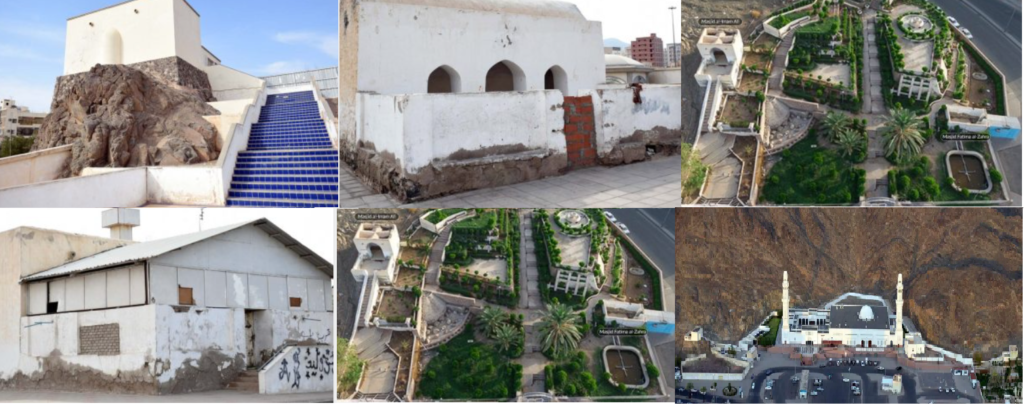
- Masjid al-Fath (مسجد الفتح) is the largest of the group of mosques known as al-Masajid al-Sab’a ( المساجد السبعة) or The Seven Mosques. It is the site at which the Prophet ﷺ supplicated during the Battle.
- Masjid Salman al-Farisi (مسجد سلمان الفارسي) is part of a group of mosques known as al-Masajid al-Sab’a.
- Masjid Fatima al-Zahra (مسجد فاطمة الزهراء) also known as Masjid Sa’d ibn Mu’adh (مسجد سعد بن معاذ) is the smallest and one of mosques of al-Masajid al-Sab’a.
- Masjid Umar ibn al-Khattab (مسجد عمر بن الخطاب) is also a part The Seven Mosques. There is also another mosque in Madinah with the same nam
- Masjid al-Imam Ali ibn Talib (مسجد الإمام علي بن أبي طالب) is one of mosques of al-Masajid al-Sab’a. There is also another mosque in Madinah with the same name.
- Abu Bakr As-Siddiq Mosque is also a part The Seven Mosques.
Muslims have a special connection to these mosques because they are situated near a section of the trench excavated during the Battle of the Trench (Khandaq) during the time of the Prophetﷺ, to protect Medina from the Quraysh.
Masjid Quba / Quba Mosque
Mosque Quba had the first stone which was installed by the Prophet Muhammad صلى الله عليه وسلم .
It is located in Medina, Masjid Quba is the world oldest mosque, and it is one of the most attracted tourist places in Medina.
It is believed that that it is the very first Mosque in the world that has existed from the Prophet Muhammad’s صلى الله عليه وسلم time from the 7th century CE.
Believers believed that the Prophet Muhammad صلى الله عليه وسلم spent 14 days in this mosque, waiting for his cousin brother and son-in-law Ali علیہ السلام to be arrived in Medina.
Prophet Muhammad صلى الله عليه وسلم used to go there and offer a two rakaat-prayer.
This Mosque has large gathering space all through the year, worshippers and visitors frequently visit this Mosque to offer the prayers.
It has most beautiful architecture with classic interior.
It has capacity of 30,000 persons at a time, with 6 Domes, 4 Minarets.
Masjid al-Jummah
Masjid al-Jummah ( مسجد الجمعة) is a mosque located on the site where the Prophet ﷺ led the first Friday prayer after his arrival in Madinah.
Masjid Abu Bakr Siddiq
Masjid Abu Bakr al-Siddiq (مسجد ابي بكر الصديق) is a mosque situated on a site where the Prophet ﷺ is reported to have performed Eid Salah.
Masjid Al-Suqya
Masjid al-Suqya ( مسجد السقيا) is a mosque where the Prophet ﷺ prayed and supplicated for the well-being of the Muslims of Madinah, before departing for the Battle of Badr.
Masjid Dhul Hulayfah
Masjid Dhul Hulayfah ( مسجد ذي الحليفة) also known as Masjid al-Shajarah ( مسجد الشجرة) is a mosque which serves as the Miqat for pilgrims travelling from Madinah to Makkah.
Masjid Imam Ali
Masjid al-Imam Ali ibn Talib (مسجد الإمام علي بن أبي طالب) is a mosque located at the site at which the Prophet ﷺ is reported to have performed Eid Salah.
Masjid al-Ghamama
Masjid al-Ghamama ( مسجد الغمامة) is a mosque situated on the site where the Prophet ﷺ performed the Eid prayer in Madinah.
Masjid Al-Anbariya
Masjid al-Anbariya (مسجد العنبرية) is a mosque located southwest of Masjid al-Nabawi, built by the Sultan of the Ottoman Empire, Abdul Hamid II in 1908 (1326 AH).
Masjid al-Ijabah
Masjid al-Ijabah ( مسجد الإجابة) is one of the oldest mosques in Makkah, having been built around 3 AH (624 CE).
The Prophet ﷺ is reported to have prayed in this location.
Masjid al-Manaratain
Masjid al-Manaratain (مسجد المنارتين) is a mosque built at the location where the Prophet ﷺ had prayed.
It was rebuilt and expanded during the reign of King Fahd bin Abdulaziz in 2003 (1424 AH).
Masjid al-Mughaisla
Masjid al-Mughaisla ( مسجد المغيسلة) also known as Masjid Bani Dinar (Arabic: مسجد بني دينار) is a mosque where the Prophet ﷺ would often pray.
Masjid al-Misbah, Masjid Bani Aneef
Masjid al-Misbah (مسجد المصبح) also known as Masjid Bani Aneef (Arabic: مسجد بني أنيف) is a mosque located southwest of Masjid Quba.
Masjid al-Mustarah
Masjid al-Mustarah (مسجد المستراح) also known as Masjid Bani Haritha (Arabic: مسجد بني حارثة) is a mosque situated on the site where the Prophet ﷺ rested and prayed upon his return from the Battle of Uhud.
Masjid al-Shaikain
Masjid al-Shaikhain (مسجد الشيخين) also known as Masjid al-Dar’a (Arabic: مسجد الدرع) is a mosque which marks the location where the Prophet ﷺ prayed before the Battle of Uhud.
Masjid Al-Fadhikh
Masjid al-Fadhikh (مسجد الفضيخ) also known as Masjid al-Shams (مسجد الشمس) was a mosque where the Prophet ﷺ and his companions prayed during the siege of Banu Nadir.
Masjid al-Rayah
Masjid al-Rayah ( مسجد الراية), also known as Masjid al-Jowdariyyah (Arabic: مسجد الجودرية), was a mosque which marked the site on which the Prophet ﷺ erected a flag to commemorate the successful conquest.
Masjid al-Sabaq
Masjid al-Sabaq ( مسجد السبق) was a mosque which was built in an area where horses were trained in preparation for Jihad during the time of the Prophet ﷺ.
The mosque has since been demolished.
Masjid al-Sajdah (Masjid Abu Dhar al-Ghifari)
Masjid al-Sajdah (مسجد السجدة) also known as Masjid Abu Dhar al-Ghifari ( مسجد ابي ذر الغفاري) is a mosque located about 900 metres north of Masjid al-Nabawi.
Masjid al-Tawba
Masjid al-Tawba (مسجد التوبة) also known as Masjid al-Asba (Arabic: مسجد العصبة) is a mosque situated within a botanical garden where the Prophet ﷺ prayed.
Masjid Bani Abdul Ashhal
Masjid Bani Abdul Ashhal (مسجد بني عبد الأشهل) also known as Masjid Waqim (Arabic: مسجد واقم) was a mosque in which the Prophet ﷺ once offered Maghrib Salah.
Masjid Bani Ghifar
Masjid Bani Ghifar (مسجد بني غفار) is a mosque situated on the south east side of Jabal Sela, in which the Holy Prophet ﷺ had prayed.
Masjid Bani Haram
Masjid Bani Haram ( مسجد بني حرام) is a mosque situated west of Jabal Sela and stands in an area where the Holy Prophet ﷺ performed a miracle during preparations for the Battle of Khandaq.
Masjid Juhaina
Masjid Juhaina ( مسجد جهينة) is a mosque that was established by the Prophet ﷺ for the groups of Juhaina and Bali.
Masjid Mashrabat Umm Ibrahim
Masjid Mashrabat Umm Ibrahim (مسجد مشربة أم إبراهيم) was a mosque situated on the site where the son of the Prophet ﷺ and his wife Maria al-Qibtiyya رضي الله عنهما, Ibrahim رضي الله عنه was born.
Wells in Medina

Wells in Medina hold great importance due to their historical significance, association with Islamic traditions, spiritual cleansing purposes, role as community gathering points, and preservation of the city’s cultural heritage.
They are revered and cherished by Muslims and are an integral part of the sacred landscape of Medina.
Wells in Medina has also some historical views, so visitors have to know about wells which are in Medina.
Bir al-Ihn (بئر العهن)
Bir al-Ihn (بئر العهن) also known as Bir al-Yasra (Arabic: بئر اليسرة) was a well that the Prophet ﷺ would drink from.
Ghars Well Bir Ghars
(بئر غرس) was one of the wells that was favoured by the Prophet ﷺ due to the freshness of its water. The Prophet ﷺ drank from the well, made Wudhu with its water and requested that he be washed using…
Well of Uthman Bir Uthman
(بئر عثمان) also known as Bir Rumah (Arabic: بئر رومة) was a well that was purchased by Uthman ibn Affan رضي الله عنه for the benefit of the Muslim community of Madinah, after the Prophet’s ﷺ…
Mountains in Medina
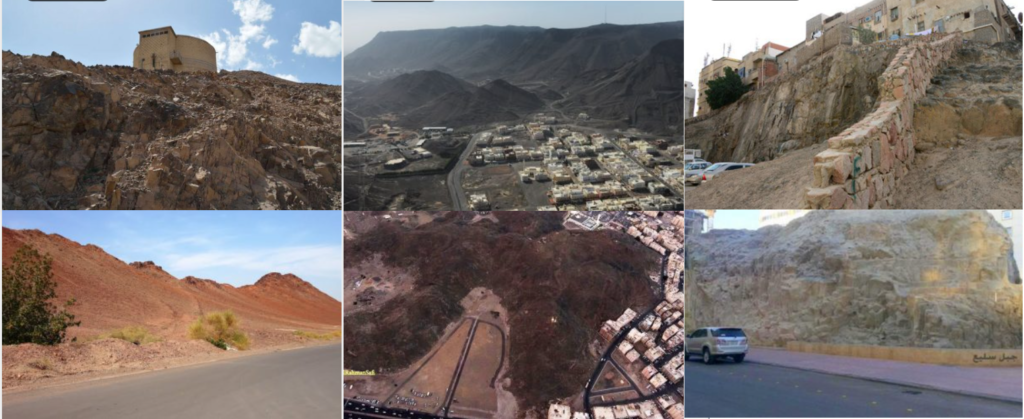
Mountains often hold symbolic value in various cultures and religions.
They can represent strength, stability, and resilience.
In the case of Medina, the few hills and elevated areas serve as symbols of the city’s historical and spiritual significance, reminding people of the events and teachings associated with those locations.
In the context of Medina, the presence of hills and elevated areas offers individuals a chance to retreat, reflect, and engage in spiritual activities.
It provides a peaceful environment away from the bustling city, allowing for introspection and connection with God.
Most famous known mountains are;
Jabal An’am ( جبل أنعم)
Jabal An’am ( جبل أنعم) is a mountain located to the right of Wadi al-Aqeeq.
The castle on top of the mountain was built by the Ottoman Sultan, Abdulmejid I during the siege of Madinah.
Jabal Ayr (مجبل أنعم)
One of Medina’s most revered historical sites is the Jabal Ayr.
The southern boundary of Medina is defined by Mount Ayr, which is the second-largest mountain in Medina after Uhud.
Jabal Ayr was referred to by the Prophet ﷺ as the Mountain of Hell.
The Prophet ﷺ claimed that Uhud was the mountain that loved everyone and was adored by Humans; as a result, it became known as the “Heaven Gate.”
However, Ayr was a place where everyone loathed everyone other, which is how it earned the nickname “Hell Gate.”
According to Muslim sages, even the Men of Al Madinah belonged to two different parties, one of which was favourable to the Prophet and the other was not.
Jabal Mukaimin ( جبل مكيمن)
This Jabal ( جبل مكيمن) is a small reddish mountain located to the southwest of Madinah.
Jabal Sela ( جبل سلع)
In Jabal Sela ( جبل سلع) is a mountain located about 500 metres west of Masjid al-Nabawi. It is about one kilometre in length and 80 metres in height.
Jabal Sulaya ( جبل سليع)
Jabal Sulaya ( جبل سليع) is a small mountain located about 500 metres from Masjid al-Nabawi.
Jibal al-Jamawat (جبال الجماوات)
Jibal al-Jamawat (جبال الجماوات) is a group of three small mountains clustered to the west of Madinah, extending over part of Wadi al-Aqeeq.
Mount Uhud
Mount Uhud is one of the most main tourist attraction in Medina, that observes the most remembered battle between Meccans forces and Muslims in 625 CE.
You have to conquer small hill to reach the Mount Uhud to see the burial places of 50 Prophet’s ﷺ fellows, most notable his beloved uncle Hamza ibn Abdul Mutalib.
This Mount is located Medina’s north and it is only 5 to 6 KM away from Prophet’s صلىﷺ Mosque.
The most notable is Ghar Uhad where Prophet Muhammad ﷺ strived refuge.
Places in Uhud
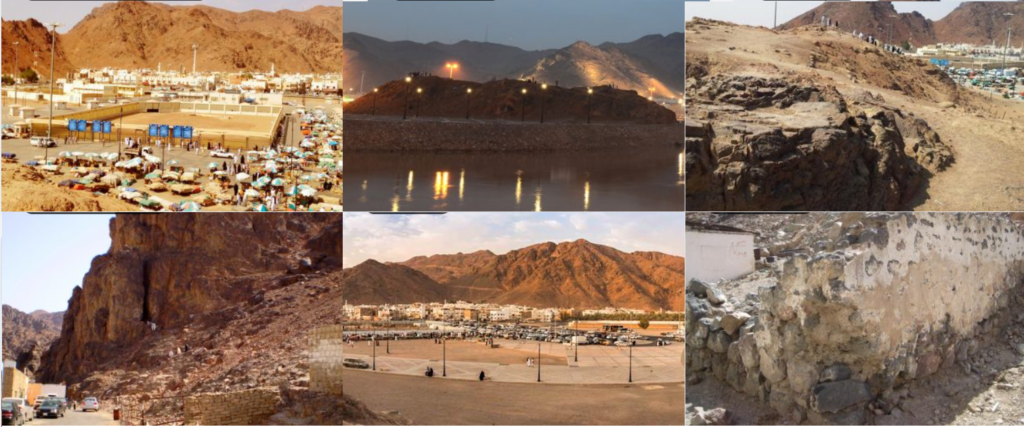
Martyrs of Uhud
The Martyrs of Uhud Cemetery (مقبرة شهداء أحد) contains the bodies of 70 Shuhada (martyrs) who were killed during the Battle of Uhud, the most notable being the uncle of the Prophet ﷺ, Hamza ibn Abdul Muttalib.
Jabal al-Rumah
Jabal al-Rumah (Arabic: جبل الرماة), also known as Jabal Ainain (جبل عينين), is a small mountain located near Jabal Uhud where Muslim archers were positioned during the Battle of Uhud.
Masjid Ainain
Masjid Ainain (مسجد عينين) is a small mosque located on the southeastern corner of Jabal al-Rumah. Only its brick walls remain today.
Cave of Mount Uhud
The Cave of Mount Uhud (غار جبل احد) is the location where the Prophet ﷺ and some of his companions retreated to during the Battle of Uhud.
Jabal Uhud
Jabal Uhud ( جبل أحد) is the largest mountain in Madinah, measuring 1,077 meters. It was the site of the Battle of Uhud, the second military encounter between the Muslims and Meccan forces.
Masjid Fash
Masjid al-Fash ( مسجد الفسح) is a mosque at the base of Mount Uhud where the Prophet ﷺ is reported to have prayed on the day of the Battle of Uhud.
The Holy Quran Exhibition
The display of the Holy Quran is one of the informative tourist destinations in Medina, which explains the background and significance of the Qur’an, the holy book of Islam.
The book is a compilation of up to nine genuine Qurans, the earliest of which has an elaborate, two-century-old copy and dates back to 1563.
The show offers benefits in English as well, although wordy signs predominate.
Due to the high number of pilgrims who visit this exhibition in Medina, it can become a little boisterous.
Wadi-e-Jinn
Wadi-e-Jinn is the place where cars have been observed to move even with their engines off, which is an unusual phenomenon.
Due to the valley’s mystique, visitors frequently arrive in their cars, which are then seen turning off and driving towards the hill.
However, the phenomena is not normal and is known as the “reverse gravity effect,” where mountains in some regions are said to have an overwhelming magnetic attraction, causing vehicles or any other iron-containing vehicle to be drawn to the hill and move upward.
Dar Al Madinah Museum
Dar Al Madinah Museum is one of the most educational locations to visit in Medina.
That is so because the museum showcases Medina’s history and heritage through the utilization of a number of unique photographs, visual galleries, and archaeological collections.
The museum exhibits about 2000 rare artifacts that capture Medina culture and legacy in addition to capturing the region’s people, scenery, and historical development.
The growth of the Masjid Nabawi from a cottage to a courtyard to the vast edifice it is today is one of the tour’s most remarkable features.
Sheikh Salama Rashdan Muesum
One of the most impressive locations to visit in Medina is this heritage museum, which features a diverse collection of vehicles, antiques, and period furniture.
Old exhibition halls with a rich history may be seen in Sheikh Salama Bin Rashdan Al Juhani’s historical district.
This is a great place to be if you’ve always wanted to see some of the historical treasures preserved in the shape of legendary cars.
No other location retains Medina’s history as well as this museum, making it worthwhile to visit.
So, if you’ve always wanted to see some old Saudi history and treasures with historical significance, don’t miss out on this one, best place to visit.
Jannat Al-Baqi / Al-Baqi Cemetery
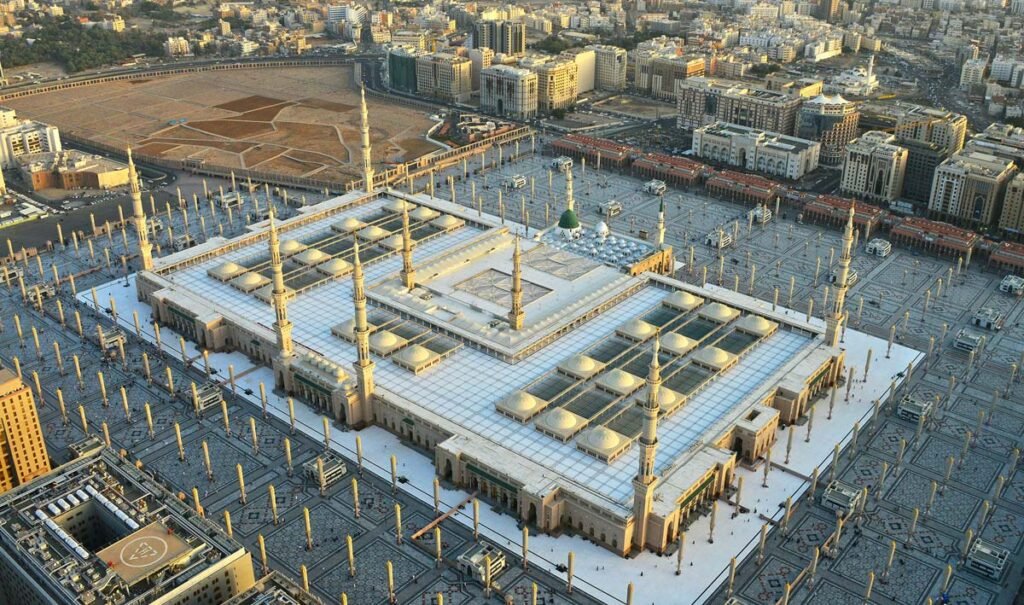
From the balcony of the Bab Abdulaziz minaret, a contemporary aerial view of the cemetery looking east.
Jannatul Baqi meaning “Garden of Baqi”), also known as Baqi al-Gharqad is the main cemetery in Madinah, located to the southeast of Masjid al-Nabawi.
It contains the graves of many prominent members of the Prophet’s family ﷺ, as well as graves belonging to the Sahabah, Tabi’in, scholars and righteous people.
It has three entrances; one on the north side, another on the east and its main entrance is on the western side. This entrance is used by visitors and for when burials take place.
The Prophet ﷺ is reported to have said:
From this cemetery (i.e. Baqi) emerges a light that will illuminate the heavens and the Earth.
Athar al-Madinah al-Munawwarah p172
Many of Prophet Muhammad’s ﷺ family members and companions are buried on the grounds of al-Baqi’, one of Islamic tradition’s two holiest cemeteries.
It is usually open twice a day – in the morning after the fajr prayer and in the afternoon after the asr prayer. Burials in the graveyard take place daily after each prayer.
Asa’ad Bin Zararah was the first person to be interred there after the Prophet Muhammad ﷺ arrived in Medina and the location was designated as a burial ground.
Bayt al-Ahzan (the House of Sorrows)
After the death of the Prophet ﷺ , the Prophet’s daughter, Fatima al-Zahra suffered tremendous grief.
Her husband, Imam Ali, pitched a tent for her in Jannatul Baqi close to Aqil’s house where she could rest and mourn, then built a house in this location, known as Bayt al-Ahzan – the House of Sorrows.
Hazrat Fatima رضي الله عنه was buried here during the Ottoman Empire in a mausoleum called the Mosque of Fatima or the Dome of Sadness.
From the Writer’s Desk
These are the places to visit in Madinah as well a lot of other information which can help you a lot.
If we have missed anything or you want to add something from your own, do comment below.
Don’t forget to hit share button, as it help us to grow.
Till the next time!
